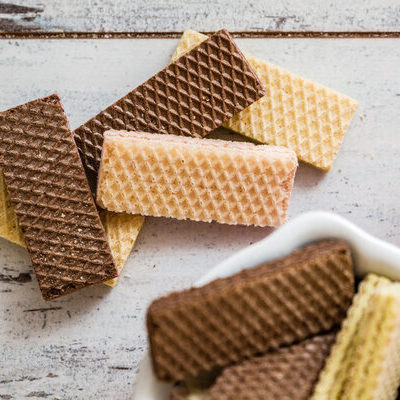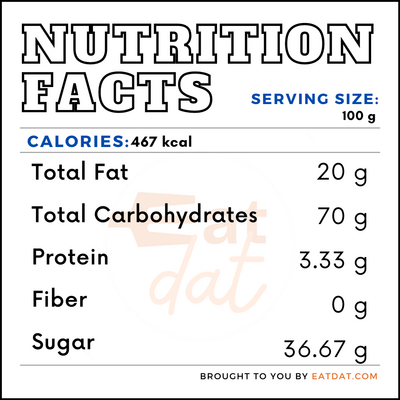
Wafer
What is a Wafer?
A wafer is a light, sweet, and crispy cookie often used as a garnish or as an ingredient that brings crunch to confections. These cookies are made from flour and water dispersions with a small amount of fat, sugar, salt, and sodium bicarbonate, and then pressed in pre-heated molds.
- Wheat flours are generally employed, although there is no designated flour for producing this snack.
- This food is often commercially used as a decoration for ice cream. It is also a snack food, as well as a component of several top-selling confectionery products.
The top 10 most popular wafer brands are:
- Little Debbie
- Nilla
- Nestle
- Kit Kat
- Lance
- Baker’s Treat Grocery
- Bauducco
- Crema de pirouline
- Rugar
- Archer Farms
Origin of wafer
The origin of wafers can be traced to ancient Egypt; however, its various names are generally of late Medieval origin. In Latin, ‘oblatao’ and ‘oblatum’ were words used to denote cakes made with unleavened flour and water. The flour and water mixture was worked into thin flat round or square sheets of pastry and baked until crisp using a press. Also, several Renaissance cookbooks have wafer recipes written in them. This cookie is believed to have been available in Paris as early as the 14th century.
In the late Medieval era, these snacks were an essential constituent of the issue de table, the court ceremony after a state meal. This snack remained an important element of the dessert course centuries later. The 1766 French desserts were composed of both curled and flat wafers filled with chocolate and fruit pastes. Today, this cookie is still popular and can be found in a variety of sweet confections.
Nutrition
According to the USDA, a 100g serving of this food contains:

This food has some possible health benefits. It contains crude fibres that can clean the body and aid digestion. Also, it contains a lot of calories in a small bite, making it convenient to carry and suitable to eat when hungry because it gives energy to the body. However, due to its level of sugar, when this food is eaten in excess, it can cause tooth decay. Furthermore, medical personnel and practitioners advise people with certain health conditions like high blood sugar, obesity, and full-blown diabetes to avoid wafers.
Commercial Production
There are several ingredients needed in the commercial production of this food. They include: flour, water dispersions (also known as batter), salt, fat, sugar, and sodium bicarbonate, or yeast.
The production steps for this cookie include:
- First, the ingredients are mixed in confined pre-heated molds.
- Next, gases and steam generated during baking provide pressure and moisture to the batter. This moisture of about 50-60% falls to a low level, typically around 1% at the end of the baking process.
- Then, the batter is spread and fills the volume between baking plates leading to the generation of carbon dioxide, which is a major leavening force in wafer baking.
- After that, the solid phase is consolidated and involves starch gelatinization. The granules of the batter increase, and the mixture becomes viscous.
- Finally, the last stage involves heat transfer, and the change in heat transfer can influence the rate of starch gelatinization. The wafer texture is influenced by the manipulation of heat delivery to the batter. The heat weakens the cells of the batter mixture, and it becomes thinner and crispier.
The worldwide wafer biscuits market is expected to grow at a rate of 5.12% from 2021 to 2026.
Application
This food is easy to make at home, using the following steps:
- In a bowl, stir softened butter and light foamy sugar. Gradually add flour and other ingredients. Gently mix into a smooth, soft dough.
- Then, cover the dough and refrigerate for no less than 3-4 hours.
- With a teaspoon, make little dollops of about 12-15 g (approximately ½ oz) per piece. Then, place one dollop (depending on your waffle/wafer machine’s size, you might fit more) on the well-preheated surface of the waffle.
- Finally, cover the upper lid and bake the wafer under pressure for 1 to 1 ½ minutes or until it turns golden brown.
When storing this food, jars and plastic bags are recommended. After the wafer is placed in an airtight jar, it should be stored in a cool, dry place to avoid being damaged by heat.
Wafer recipes
This snack blends well with a variety of foods. Here are a few recipes:
FDA Regulation
The Food and Drug Administration does not currently have a standard of identity for this food. However, it regulates the reference amount consumed per eating occasion for this snack. The FDA also outlines the factors and general principles they considered in arriving at the calculation. Furthermore, the body provides guidance for industries to follow concerning hazard analysis and risk-based prevention control for foods. This covers everything about the raw materials and ingredients used in preparing this cookie.
References
“The Science behind the Flat Wafer Baking Process.” New Food Magazine, 20 Apr. 2017, www.newfoodmagazine.com/article/8661/the-science-behind-the-flat-wafer-baking-process/
“Home-Made Ice Cream Wafers.” Chef’s Pencil, 1 Nov. 2018, www.chefspencil.com/recipe/home-made-ice-cream-wafers/.
CFR – Code of Federal Regulations Title 21.” Accessdata.fda.gov, U.S Food & Drug Administration, 1 Apr. 2019, https://www.accessdata.fda.gov/scripts/cdrh/cfdocs/cfcfr/CFRSearch.cfm?fr=101.12&SearchTerm=wafers
